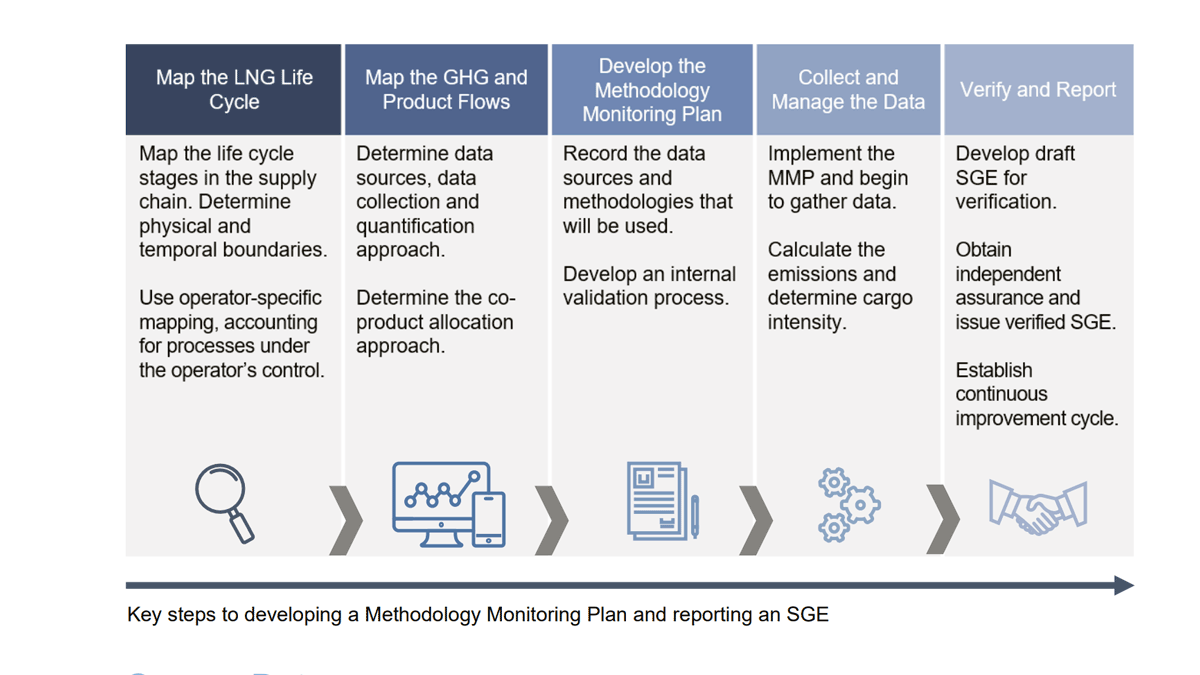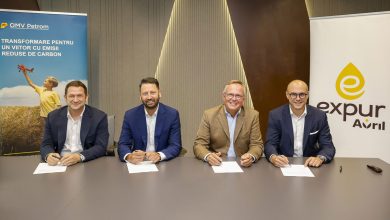SGE Methodology for Delivered LNG Cargoes
Pavilion Energy, QatarEnergy and Chevron have jointly published a quantification and reporting methodology to produce a statement of greenhouse gas emissions (SGE) for delivered LNG cargoes.
This is the first such published methodology that will be applied to sales and purchase agreements (SPAs), specifically the executed SPAs2 by Pavilion Energy with QatarEnergy and Chevron. Intended for wide adoption, the methodology provides a calculation and reporting framework for greenhouse gas (GHG) emissions from wellhead-to-discharge terminal, based on industry standards.
The SGE Methodology was developed by a team of technical specialists representing Pavilion Energy, QatarEnergy and Chevron, supported by global sustainability consultancy Environmental Resources Management (ERM). It aims to create a common standard for the measurement, reporting and verification of the GHG emissions associated with producing and delivering an LNG cargo to drive greater transparency and enable stronger action on GHG reduction measures.
Independent academic experts, commercial institutions and verification bodies have reviewed the SGE Methodology. It complements key industry efforts being developed in parallel, specifically the Monitoring, Reporting and Verification (MRV) and GHG Neutral Framework by the International Group of LNG Importers (GIIGNL).
“We share a common and decisive vision with QatarEnergy and Chevron to advocate for transparency and accuracy of GHG emissions associated with delivered LNG cargoes,” said Alan Heng, Interim Group CEO of Pavilion Energy. “The SGE Methodology sets a strong tone for increased accountability of emissions along the LNG value chain, paving the way for more decarbonisation strategies towards a lower carbon future.”
“This joint effort to develop a greenhouse gas quantification and reporting methodology is part of a series of projects and initiatives that reflect QatarEnergy’s commitment to reduce GHG emissions and to de-carbonize the LNG value chain. We are proud to join hands with our partners Pavilion Energy and Chevron in this landmark project,” Ahmad Saeed Al-Amoodi, QatarEnergy’s Executive Vice President of Surface Development and Sustainability, noted.
“We jointly developed this LNG carbon footprinting methodology for delivered cargoes to help advance a standard for GHG product-level accounting,” added Bruce Niemeyer, Chevron’s vice president of strategy and sustainability. “This methodology is expected to enhance transparency, improve accuracy and build stakeholder confidence in data reliability to help advance net zero ambitions.”
The Statement of Greenhouse Gas Emissions (SGE) Methodology is one of the first published methodologies specifically developed to quantify the greenhouse gas (GHG) emissions associated with a delivered liquefied natural gas (LNG) cargo. It provides a measurement, reporting and verification methodology which compliments common GHG reporting processes to deliver a consistent, verified SGE for each delivered LNG cargo.
The SGE Methodology is intended for industrywide adoption and is applicable across the LNG value chain – from wellhead to delivery point. It can be used by integrated producers and operators of individual segments that contribute to the value chain GHG footprint.
Carbon Footprint Quantification
The SGE Methodology is based on the principles of coherence, relevance, completeness, consistency, transparency, and accuracy.
Coherence: The SGE Methodology provides a measurement, reporting and verification methodology based on industry standards and enables LNG sellers to develop and adapt their internal GHG reporting processes to deliver a SGE for each cargo.
Relevance and completeness: The SGE Methodology covers operational emissions associated with all life cycle stages from production wellhead to delivery point, including an incoming ballast voyage and in-port emissions for shipping. Emissions associated with operation of the discharge terminal through to end user are not addressed but could be added as a separate component to fulfil a “cradle-to-grave” life cycle assessment.
Consistency: The SGE is quantified and reported per cargo both as total GHG emissions, expressed as carbon dioxide equivalent (CO2e), emissions intensity per energy content delivered, expressed as tCO2e/mmBtu, and methane intensity per energy content delivered, expressed as tCH4/mmBtu. At a minimum, emissions of carbon dioxide (CO2), methane (CH4), and nitrous oxide (N2O) must be included. All emissions are expected to be allocated appropriately to LNG and all other co-products.
Transparency and accuracy: Each SGE is subject to independent third-party verification.
The SGE Methodology includes the development and maintenance of a Methodology Monitoring Plan (MMP). The MMP is a documented procedure that sets out how the reporter intends to meet the criteria established in the SGE Methodology, and it clearly identifies emission sources, calculation approaches, and internal controls.
Source Data
The SGE Methodology requires reporters to use the highest-quality data available. For operated assets, the best available data is expected to be primary data, where data is sourced from operations and is specific to the value chain of the delivered LNG.
For third-party sourced inputs or products, the SGE Methodology provides a tiered approach using secondary (non-specific) data where primary data is not available. Use of primary data is expected to increase over time and, in all cases, the data used will be transparently presented for assurance to a third-party verifier.
Assurance
Consistent with the principles of transparency and accuracy, the SGE Methodology sets out the ambition that SGEs will achieve a reasonable level of assurance by a third-party verifier.
The verifier will assure that the SGE has been calculated per the SGE Methodology and that there are no material errors or omissions in the reported SGE.
Continuous Improvement
Over time, both the SGE Methodology and its application are expected to evolve as more detailed and granular source data become available and as industry regulations and GHG reporting standards advance. Industry should strive to improve the data quality and the transparency of their value chains over time and to demonstrate continuous improvement in reducing the uncertainty level of the SGE.
In conclusion, the developers of the SGE Methodology welcome working with the LNG industry to promote further advancement of product carbon footprinting.
See the paper here: https://www.chevron.com/-/media/chevron/sustainability/documents/SGE-methodology.pdf







